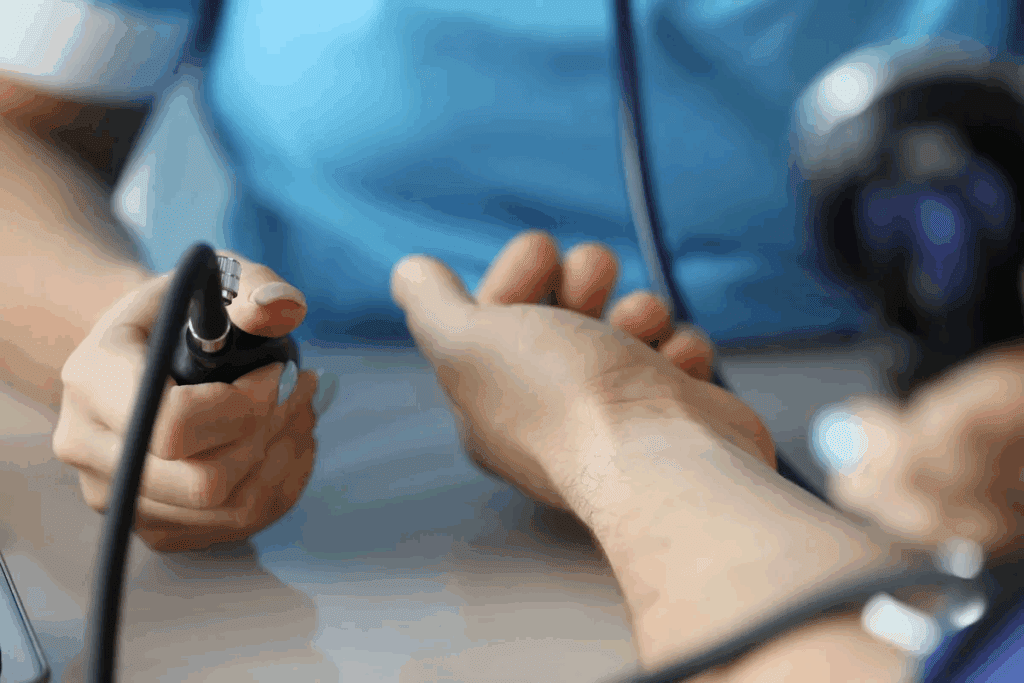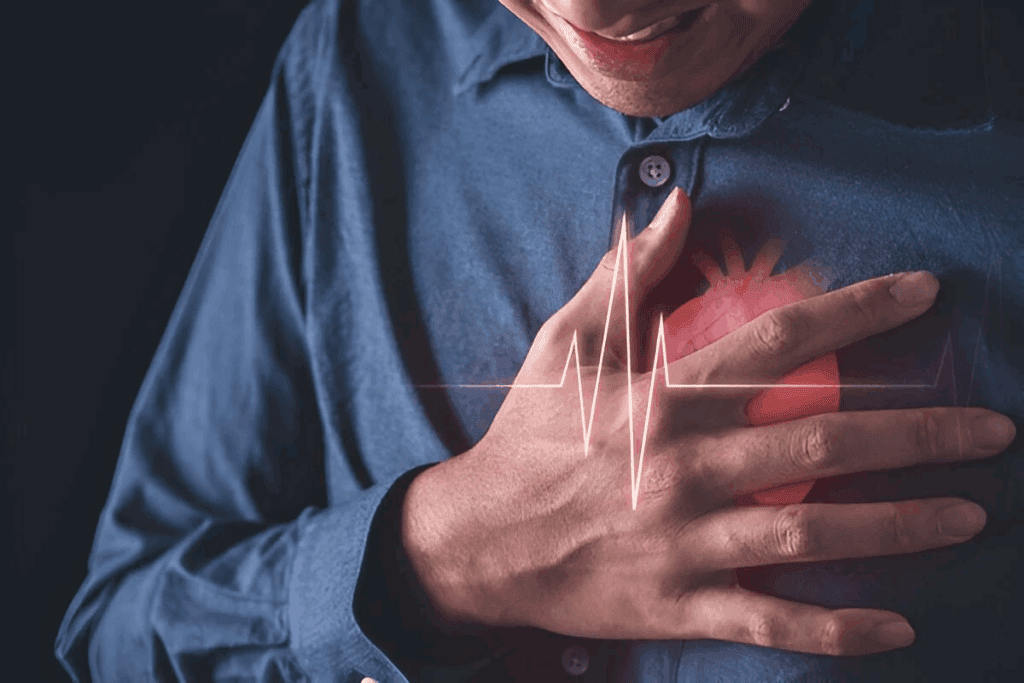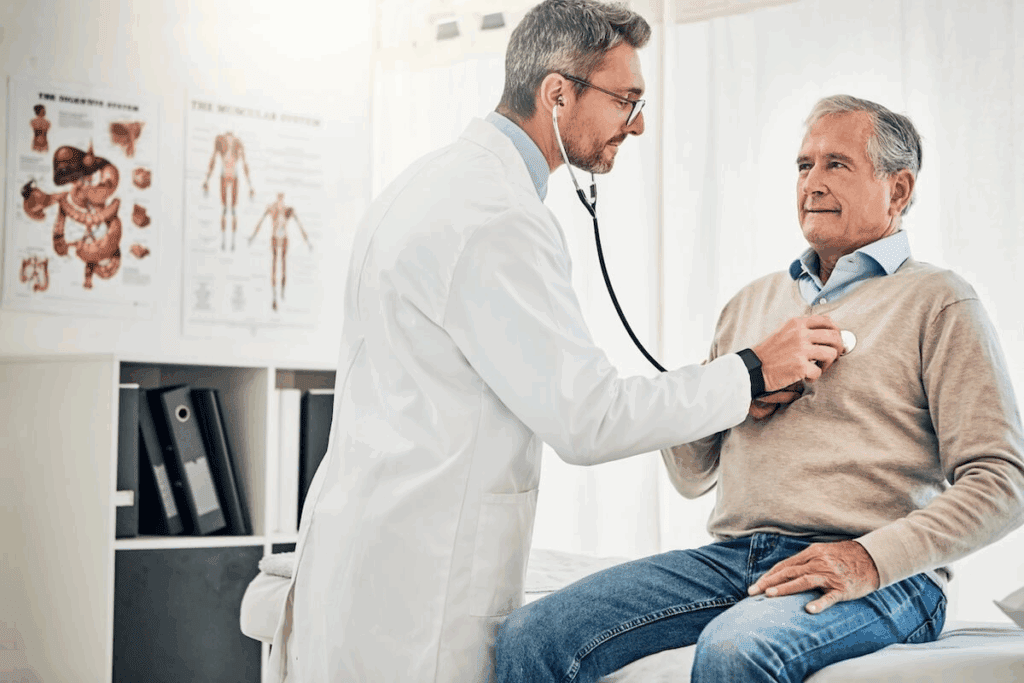Last Updated on November 25, 2025 by Ugurkan Demir

Ever felt pain in your chest after working out or playing sports? Pectoral muscle pain is common among both men and women. At Liv Hospital, we know that underlying causes can be different. They range from muscle strain to serious health problems.
Muscle strain is a big reason for pectoral muscle soreness. It often happens when you use your muscles too much or do exercises wrong. Knowing what causes it and spotting the signs is key to easing the pain.

The pectoral muscles are key for many movements and keeping our posture right. The pectoralis major and minor muscles help us move our arms, breathe, and move our upper body.
The pectoralis major is a big, fan-shaped muscle on our chest. It starts from the clavicle, sternum, and ribs, and ends in the humerus. This muscle helps us flex, adduct, and rotate our arms.
The pectoralis minor is smaller and under the major. It starts from the ribs and ends in the scapula. It helps with scapular rotation and elevation.
There are two main pectoral muscles: the pectoralis major and the pectoralis minor. The major muscle has two heads. The clavicular head starts from the clavicle, and the sternocostal head starts from the sternum and ribs.
The pectoral muscles are important for arm movements and keeping our posture. Pectoral muscle pain can make daily tasks hard. Knowing how they work is key to treating pain.
In short, the pectoral muscles are complex and vital for our upper body and posture. Understanding them helps in diagnosing and treating pain in the pectoralis muscle.

Many people feel pain or discomfort in their pectoral muscles. This is due to different reasons. Knowing these causes helps in preventing and managing the pain.
Strain from exercise is a common reason for pectoral muscle pain. Weightlifting, push-ups, and chest exercises can strain the muscles. Not using the right form during these activities can lead to muscle tears.
Overuse injuries happen when muscles are stressed too much without rest. This is common in athletes or those who do sports that involve throwing or repetitive arm movements. Pain that starts slowly is a sign of overuse injuries.
Direct trauma to the chest, like from a fall or collision, can also cause pain. The impact can bruise, strain, or tear the muscle. Pain right after the injury is a common symptom.
Poor form during workouts is another big cause of pectoral muscle pain. Wrong technique can strain the muscles, leading to injury. Getting proper training and supervision can help avoid these problems.
Pain in the pectoralis muscle can tell us a lot about what’s causing it. It can feel sharp or dull, or even like a cramp. The type of pain often shows how severe the injury is.
Pain in the pectoralis muscle can be sharp or dull. Sharp pain is intense and focused, often from a direct hit or sudden pull. Dull pain spreads out and lasts longer, usually from too much use or repetitive strain.
Cramps and spasms in the pectoral muscle are sudden and painful. They can happen from not drinking enough water, not having the right balance of salts, or being very tired. Spasms might come from too much use, a direct hit, or heavy lifting. To manage these, it’s important to find and fix the cause, like drinking more water or changing how you exercise.
Feeling sore or tight in the pectoralis muscle after working out is common. This is called delayed onset muscle soreness (DOMS). It starts hours after and can last for days. It’s because the muscle fibers have tiny tears. To feel better, try gentle stretching, warm baths, and slowly getting back to your workout routine.
Sometimes, pain from the pectoralis muscle feels like it’s coming from other places, like the arm, shoulder, or chest. This is because the nerves that supply the pectoralis also cover these areas. This makes it hard to figure out where the pain is coming from. A detailed check-up and understanding of these patterns are key to finding and treating the problem.
| Type of Pain | Characteristics | Possible Causes |
| Sharp Pain | Intense, localized | Direct trauma, sudden strain |
| Dull Pain | Diffuse, chronic | Overuse, repetitive strain |
| Cramps/Spasms | Sudden, involuntary contractions | Dehydration, electrolyte imbalance, muscle fatigue |
| Soreness/Tightness | Develops after exercise, lasts for days | Micro-tears in muscle fibers (DOMS) |
Pectoral muscle pain can really mess up your day. It makes moving and feeling good hard. When your pectoral muscles hurt, it’s not just about moving. It’s about feeling okay too.
One big problem with pectoral muscle pain is moving your arms. Even simple things like lifting or reaching hurt. It makes doing everyday stuff, like getting dressed or cooking, really tough.
Pain in your pectoral muscles can mess with your sleep. It hurts when you lie on your chest or side. This makes it hard to sleep well, leading to tiredness and feeling sick.
Doing simple tasks becomes hard when your pectoral muscles hurt. Even things like driving or working on a computer hurt. It makes you feel frustrated and lowers your quality of life.
If you like to exercise, pectoral muscle pain is a big problem. It makes it hard to do chest workouts like push-ups or bench presses. This hurts your fitness goals and progress.
In short, pectoral muscle pain is more than just a minor issue. It affects your daily life, sleep, and exercise. Knowing why it happens and finding ways to feel better is key to getting back to normal.
Pectoral muscle pain affects both men and women, but it’s different for each gender. The way people feel pain in their chest muscles varies due to body differences. These differences are in how muscles are built and how the body reacts to pain.
Men and women have different chest muscles. Women usually have more body fat, which can change how they feel pain. Also, women’s breasts can sometimes make it hard to tell if chest pain is from the muscle or the breast.
Women get chest muscle pain from many things, like working out too hard or not standing right. Doing too much upper body exercises can strain the chest muscles. Lifting heavy things or doing the same motion over and over can also cause pain.
It’s hard to tell if a woman’s chest pain is from her muscles or her breasts. Breast pain can come from many things, like hormones or cysts. Doctors need to look closely at where the pain is to figure out the cause.
Hormones can make muscle pain worse, including chest muscle pain. In women, changes in hormones can make muscles more sensitive. This can make some women feel more pain during certain times of their cycle.
| Factor | Women | Men |
| Anatomical Differences | Presence of breast tissue, generally higher body fat percentage | Typically less body fat, different muscle distribution |
| Common Causes | Exercise-related strain, poor posture, hormonal influences | Exercise-related strain, direct trauma, overuse injuries |
| Diagnostic Challenges | Distinguishing from breast pain | Often related to cardiac issues or musculoskeletal strain |
It’s important to know the difference between pectoral muscle pain and heart-related chest pain. Pectoral muscle pain can be uncomfortable but not life-threatening. On the other hand, heart-related chest pain is serious and can be deadly. So, it’s key to understand the differences between these two conditions.
Pectoral muscle pain usually comes from muscle strain or injury. It causes pain that gets worse with movement or pressure. Heart-related chest pain, though, is more widespread and might come with other symptoms like shortness of breath or dizziness.
The pain’s nature is a big difference. Pectoral muscle pain is sharp and stays in one spot. Heart pain feels like pressure or heaviness in the chest. It might also spread to the arms, back, or jaw.
Knowing when to get help is critical. Severe chest pain, trouble breathing, or pain spreading to other areas are warning signs. If you have these symptoms, call for emergency care right away.
Other signs to watch for include feeling dizzy, nauseous, or like something bad is about to happen. These could mean a serious heart problem that needs quick attention.
Doctors use a few methods to figure out what’s causing chest pain. They look at your medical history, do a physical exam, and might run tests like ECGs or imaging studies.
Talking about your medical history is very important. It helps doctors understand your risk for heart problems and decide on the best tests and treatments.
Some things increase the chance of heart-related chest pain. These include heart disease, high blood pressure, high cholesterol, or smoking. If you have these risk factors, watch your symptoms closely and seek help if they worry you.
Family history also matters. If your family has heart disease, you might be at higher risk. It’s good to talk about this with your doctor.
| Symptom | Pectoral Muscle Pain | Cardiac-Related Pain |
| Nature of Pain | Sharp, localized | Pressure, heaviness, diffuse |
| Triggers | Movement, pressure | Often spontaneous |
| Associated Symptoms | Localized tenderness | Shortness of breath, dizziness, nausea |
| Radiation of Pain | Typically localized | May radiate to arms, back, jaw |
When you feel pectoral muscle pain, it’s important to find quick relief. This helps ease the discomfort and stops the pain from getting worse. There are several ways to get fast relief and manage the pain well.
One good method is using cold compresses on the sore area. Cold compresses can reduce swelling and numb the pain, giving you temporary relief. To use a cold compress, wrap an ice pack or a cold, damp cloth around the sore spot. Hold it there for 15-20 minutes. Do this several times a day if you need to.
Stretching exercises can also help loosen tight pectoral muscles. Gentle stretching can ease tension and lessen pain. Try exercises that focus on the chest and shoulders, like chest stretches and shoulder rolls. Hold each stretch for 15-30 seconds and do it several times.
Keeping a good posture is key to easing pectoral muscle pain. Bad posture can make muscle tension worse, leading to more pain. Make sure to keep a proper posture all day, when sitting or standing for a long time.
For severe pain, you might need to use over-the-counter pain relievers. But, always talk to a doctor before taking any medicine. This makes sure it’s safe and right for your situation.
By using these methods, you can quickly ease pectoral muscle pain and lower the chance of more injury. If the pain doesn’t go away or gets worse, it’s best to see a doctor. They can find out what’s causing the pain and give you the right treatment.
Aching pectoral muscles can come from many sources. Strain from exercise and overuse injuries are common. Direct trauma to the chest and poor form during workouts also play a role. These factors can cause muscle pain and discomfort.
Pectoral muscle pain is linked to movement and can be tender. Cardiac-related chest pain, on the other hand, often comes with other symptoms like shortness of breath. If you’re unsure, it’s best to see a doctor.
Pectoral muscle pain after exercise usually stems from strain or overuse. This can happen if you push too hard, use poor form, or skip warm-ups and cool-downs.
Yes, women may feel pectoral muscle pain differently due to body and hormonal differences. It’s key to tell apart pectoral muscle pain from breast pain.
Symptoms of pectoral muscle strain include sharp or dull pain and muscle cramps. You might also feel soreness and tightness after working out. Referred pain patterns are another sign.
To ease pectoral muscle pain, try the RICE protocol (rest, ice, compression, elevation). Stretching and strengthening exercises can also help. Fixing any workout form issues is important too.
Yes, pectoral muscle pain can limit arm movement and disrupt sleep. It can also make everyday tasks harder.
To avoid pectoral muscle strain, warm up and cool down right. Use proper form during workouts. Also, avoid overuse or repetitive strain.
See a doctor if you have severe pain, trouble breathing, or are unsure of the cause. It’s also wise to seek medical help if you have heart problems or other health issues.
Subscribe to our e-newsletter to stay informed about the latest innovations in the world of health and exclusive offers!